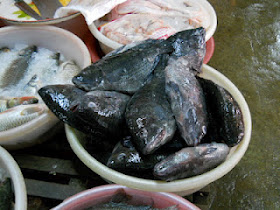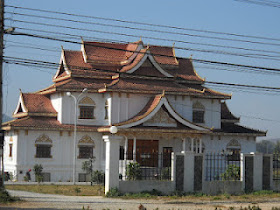 The non-aircond minibus fare was 100,000 Dong to Vinh in Central Vietnam.
The non-aircond minibus fare was 100,000 Dong to Vinh in Central Vietnam.There were many stops along the way to pick up passengers and slightly after an hour into the journey at about 5:00pm while nearing Hoa Binh,the minibus conductor start collecting the money and ask for our destination.
I was given a hint by one Vietnamese worker while at the Nam Khan Immigration Post that if my plan is to head for Hanoi,there were buses in Hoa Binh.
Being a first timer in this alien territory,it might be a difficult task in this late evening to walk around and locate Hoa Binh Bus Terminal.
Furthermore in the event that I managed to get a ticket,chances is that it will be around midnight to reach Hanoi.
At about 5:30pm,passed through Tuong Duong District with towns like Na Tong,Quang Yen,Quang Thanh,Tam Quang,Ban Long,Thah Dao and Dinh Son.
It was already getting dark at 6:30pm when we passed through Anh Son District,with Anh Son being the main town centre and then Kai Son.
Can you imagine some of the limestone karst mountains extended close to the main road and at one point there were communities living close to it.
Finally at about 8:45pm after a nine hours minibus journey,arrived in the outskirt of Vinh which is in the Nghe An Province.
It was a big city with good road infrastructure.
Bounded in the north by Thanh Hoa Province while the south is Ha Tinh Province.
Vinh was an industrial port city and was flattened completely during the Vietnam War due to it being a supply source for the Ho Chi Minh Trail.
Vinh is also the birthplace of Ho Chi Minh.

Vinh is located along Highway 1, 197 km north of Dong Hoi, and just under a hundred kilometres from the Lao border at the NamCan / Nam Khan crossing.
It's about 290 km south of Hanoi, 1,430 km north of Ho Chi Minh City, and its an express stop on the train line.
There is
National Highway No. 6 from Hanoi via Ha Tay to Hoa Binh, Son La,
National Highway No. 15 from Mai Chau to Thanh Hoa,
National Highway No. 12B from Hoa Binh to Nho Quan (Ninh Binh).
Hoa Binh Town is 76km from Hanoi.

Well I booked a 10:30pm sleeper bus to Hanoi and the fares was 150,000 Dong.
A look at Vietnamese sleeper bus.
There were three rows of upper and lower individual bunks,that is two-tiered.
The very end of the bus were with no seat numbers,just a flat cushioned platform which can accomodate five people.
There is no toilet inside the bus.
By right my ticket has a number but knowing that a foreigner couldn't argue about it, I was shown the end rows.
Immediately my aim was the corner beside the window so as to avoid being squeezed in the middle.
Unfortunately throughout the journey, the Vietnamese guy sleeping beside me tend to roll over too often giving me a miserable night.
Compared to a normal upright seats bus,a sleeper bus has the disavantage of not being able to sit up as the berth are in an inclined position just like the hospital bed.
One more thing to consider is the bunks were customed made to Asian size and if you are around six feet in height,this can be problematic.
Tuyen Ngoai Tinh 2 destinations bus timetable. (place/km distance/price(VHD)/time)
1) Saigon - 1430 -500,000 -05:00hr Old name for Ho Chi Minh City(HCMC).
2) Vang Tau -1500 -380,000 -05:00hr
Located near HCMC and Binh Duong Province majoring in shipping,oil and sunny beaches.
3) Binh Duong -1500 -430,00 -05:00hr
North of HCMC,agricultural and animal husbandry major economy.
4) Bao Loc -1285 - 470,000 -05:00hr
Central Highlands,Lam Dong Province-famous B'lao tea.130km from HCMC and 100km from Dalat.
5) Da Lat -1225 -460,000 -05:00hr
South central highlands once a popular playground during the French colonial powers.
6) Dak Lak -119 -360,000 -05:00hr
Dak Lak(Dac Lac) Province is 183km from Nha Trang (by National Highway No. 26), 180km from Pleiku (by National Highway No. 14), 352km from Ho Chi Minh City (by National Highway No. 14), 200km from Dalat (by National Highway No. 27), and 1,390km from Hanoi.Rich in National biodiversity.
 7) Hanoi -291 -130,000 -04:30 till 16:00hr Second largest city in Vietnam,old name Thanh Long.
7) Hanoi -291 -130,000 -04:30 till 16:00hr Second largest city in Vietnam,old name Thanh Long.8) Hoc Gluong Nam -160,000 -05:00 till 21:00hr (can't figure out where is this)
9) Dak Nong -1260 -450,000/500,000 - 05:00hr Central highlands province with capital Gia Nghia,has large fields and lakes.
10) Gia Lai -960 -360,000 - 05:00hr and 13:00hr Pleiku,the capital of Gia Lai Province in Central Highlands.
Strategically important during Vietnam War,primary terminus of military logistics corridor.

11) Da Nang -470 -170,000 -05:00hr
Major commercial and port city.
The city's origins date back to the ancient Champa Kingdom, established by Indonesian settlers in 192 AD
12) Hue -370 -130,000 -05:30 and 11:00hr Imperial capital of the Nguyen dynasty.
Located right in the centre bordering North and South Vietnam in the early days. Rich in historic monument,one of UNESCO's World Heritage sites.
13) Dong Hoi -220 -85,000 -12:30,13:30,14:30hr Capital of Quang Binh Province,north central coast of Vietnam,500km southeast of Hanoi.Lanching pad for air raids against Viet Minh forces in the Central of Vietnam and Laotian communist forces Pathet Lao in the Central and Southern Laos during First Indochina War.
14) Son La CLC -530 -259,000 - 18:00hr Ngay 1 Chuyen
325km north west of Hanoi bordering Lao Cai and Yen Bai in a mountainous region.
15) Son La G Nam -130 -300,00 - 18:00hr
16) Dien Bien -760 -450,00 - 17:00hr
Near Lao Cau and Son La Provinces and the capital city is Dien Bien Phu.Best known for the victorious war against French colonist on 07.05.1954.
Very mountainous with fascinating sceneries.
17) Lao Bao - x - 120,000 - 07:15hr A small town in the Hướng Hóa district of Quang Tri Province, Vietnam, located in the North Central Coast region, near the border with Laos Savan Province.
18) Ven Chan - x -280,000 - 06:00hr ngay chan am lich Vieng Chan or Vientiane,the capital city of Laos PDR

Chat Luong Cao buses timetable:(towns/km distance/fares/departure)
1) Hai Phong -396 -130,000 05:00,05:30,06:00,07:00,07:30,08:00,09:00,10:45 and 12:00hr.
Vietnam's third most populous city.
The city's name means coastal defence. 120km north east of Hanoi near the Gulf of Tonkin and just about 20km to the famous Halong Bay.One of the biggest port city.
2) Dak lak -1101 -420,000 -06:00hr Đắc Lắc,Coffee, fruit, and rubber play an important part in its economy.
3) Hanoi -291 -130,000 -04:40 and 18:00hr
4) Hanoi Huong Nam -291 -150,000 - 12;30,13:00,13:30,14:00,07;00,07;30,08:00,08:30,22:00,06:30 and 09:00hr
5) Saigon - x
6) Mong Cai Quang Nam -630 -240,000 -18:00,19:00hr
7
 ) Thai Nguyen G Nam -380 -170,000 -07:30,15:00hr
) Thai Nguyen G Nam -380 -170,000 -07:30,15:00hr8) Pon Xa Van -403 -280,000 -06:00hr Thu 2-3-5-6, Gluong Nam 350,000VND,Ngay 1 chuyen 290,000VND.
Phonsavan Province is in the north of Laos and the capital city is Phonsali.
9) Luang Pha Bang -690 -450,000 -06:00 Thu 2-4-6-7, Luang Prabang is in Laos.
10) Danang CLC nhe ngoi - 470 -120,000 - 05:30 and 06:30hr
11) Danang Gluong nam -470 -205,000 - 18:00,18:30,19:00,19:30,20:00,20:30 and 20:45hr
12) Saigon Gluong nam -4130 -780,000 -08:00hr 13) Hai Phong Gluong nam -396 -170,000 -08:00,10:00,20:00,20:15,21:30 and 22:15hr.

Cam Hut Thuoc La bus schedule:
1) Muong Xen -250km-90,000Vnd-04:00,04:30,05:00,05:30,06:40 and 07:00hr Town at the foothill near Nong Het-Nam Khan border checkpoint.
 2) Hoa Binh (Thuong Duong)-195km-75,000Vnd-04:00,04:30,05:00,05:30,06:00,06:30,07:00,07:30,08:00,08:30 and 09:00hr
2) Hoa Binh (Thuong Duong)-195km-75,000Vnd-04:00,04:30,05:00,05:30,06:00,06:30,07:00,07:30,08:00,08:30 and 09:00hrMountainous terrain with Thac Bo, Hoa Tien grottoes, Ret Cave, Pu Nooc Primitive forest and many clean springs are suitable for swimming, climbing, walking, and hunting.
Hoa Binh is a mountainous province in the North. It is bordered by Phu Tho and Ha Tay in the north, Ninh Binh and Thanh Hoa in the south, Ha Nam in the east, and Son La in the west. Apart of these, scientific tests have shown that the mineral water at Kim Boi Hot Spring is good for drinking, bathing and treatment.

3) Con Cuong -140km-60,000Vnd-05:00 till 17:00hr Nghe Ann District near Dinh Son.Nghe Ann Province highest peak is Pulaileng (2,711m high) in Ky Son District, the lower is the plains of Quynh Luu, Dien Chau, Yen Thanh districts.
4) Phuc Son -108km-50,000Vnd-05:00 till 17:00hr
5) Do Luong -75km -40,000Vnd-05:00 till 17:00hr-4:30 till 17:00hr Đô Lương is a rural district of Nghe An province in the North Central Coastal region of Vietnam.

8) Yen Thanh -70km-36,000Vnd-06:30 till 17:00hr
North Central Coast region,Northern border districts of Tan Ky , Quynh Luu , Dien Chau ; east Dien Chau District; southeast district bordering Nghi Loc , south district Luong , the west district of Tan Ky .
7) Dung (Thanh Chuong) -50,000Vnd-04:30 till 17:30hr. A rural district of Nghe An province in the North Central Coastal region of Vietnam
6) Lat (Tan Ky)-90km-50,000Vnd
Ban Phieu Xe Ra Cong bus schedule:
1) Hanoi-291km-130,000Dong
2) Kam-230km-94,000Dong
3) Thai Binh-250km-110,000Dong
4) Thai Ngyyen-380km-154,000Dong
5) Quang Ninh-460km-150,000Dong-05:00,05:30hr
6) Bac Ninh-342km-144,000Dong-04:00,ngay 1 chuyen
7) Hai Duong-354km-121,000Dong-06:00,ngay chan am lich
8) Dung Hoi-230km-85,000Dong-12:30,13:30,14:30hr
9) Hue-370km-130,000Dong-05:00 till 11:00hr 10) Thanh Hoa-153km-75,000Dong.
Bus ticket to Hanoi,sleeper bus('gluong nam')


















































